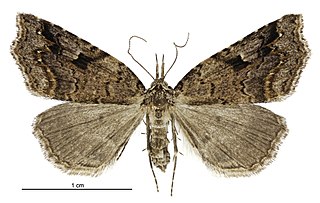
Schrankia costaestrigalis, the pinion-streaked snout, is a species of moth of the family Erebidae. It is found in Europe, the Canaries, Madeira, Syria, Armenia. It is also present in New Zealand. The species closely resembles Crambidae or Pyralidae species.

Trigonistis anticlina is a species of moth in the family Noctuidae. It is endemic to New Zealand. Adults of this species inhabit dense native forest habitat in ravines.
Commatica nerterodes is a moth in the family Gelechiidae. It was described by Edward Meyrick in 1914. It is found in Guyana.
Battaristis ichnota is a moth of the family Gelechiidae. It was described by Edward Meyrick in 1914. It is found in Guyana.
Battaristis orthocampta is a moth of the family Gelechiidae. It was described by Edward Meyrick in 1914. It is found in Guyana.
Compsolechia thysanora is a moth of the family Gelechiidae. It was described by Edward Meyrick in 1914. It is found in Peru.
Idiophantis paraptila is a moth of the family Gelechiidae. It was described by Edward Meyrick in 1916. It is found in Sri Lanka.
Stenoma recondita is a species of moth of the family Depressariidae. It is found in Guyana.
Stenoma platyterma is a moth of the family Depressariidae. It is found in Guyana.
Antaeotricha monosaris is a moth of the family Depressariidae. It is found in Guyana, French Guiana and Brazil.
Cerconota noverca is a moth of the family Depressariidae. It is found in French Guiana.
Chlamydastis synedra is a moth of the family Depressariidae. It is found in Paraguay.
Cerconota minna is a moth of the family Depressariidae. It is found in Panama, the Guianas, Bolivia and Brazil.
Stenoma emphatica is a moth of the family Depressariidae. It is found in French Guiana.
Agriophara parilis is a moth of the family Depressariidae. It is found in New Guinea.
Cryptophasa porphyritis is a moth in the family Xyloryctidae. It was described by Turner in 1906. It is found in Australia, where it has been recorded from Queensland.
Gonionota lecithitis is a moth in the family Depressariidae. It was described by Edward Meyrick in 1912. It is found in Argentina.
Cerconota tabida is a moth in the family Depressariidae. It was described by Arthur Gardiner Butler in 1877. It is found in the Brazilian states of Amazonas and Pará and in the Guianas.
Stenoma amphitera is a moth in the family Depressariidae. It was described by Edward Meyrick in 1913. It is found in Peru.
Imma tetrope is a moth in the family Immidae. It was described by Alexey Diakonoff in 1978. It is found in Nepal.

